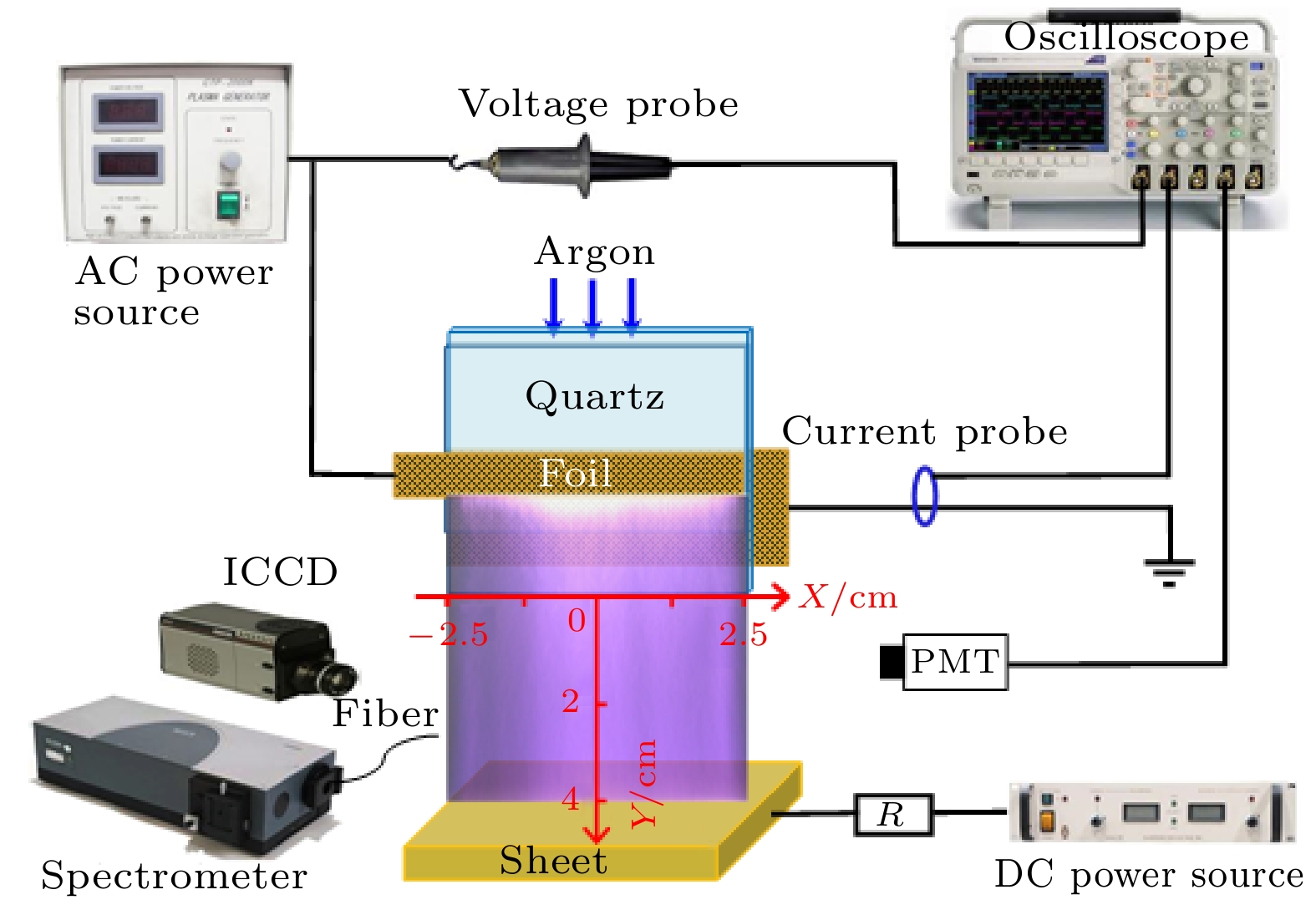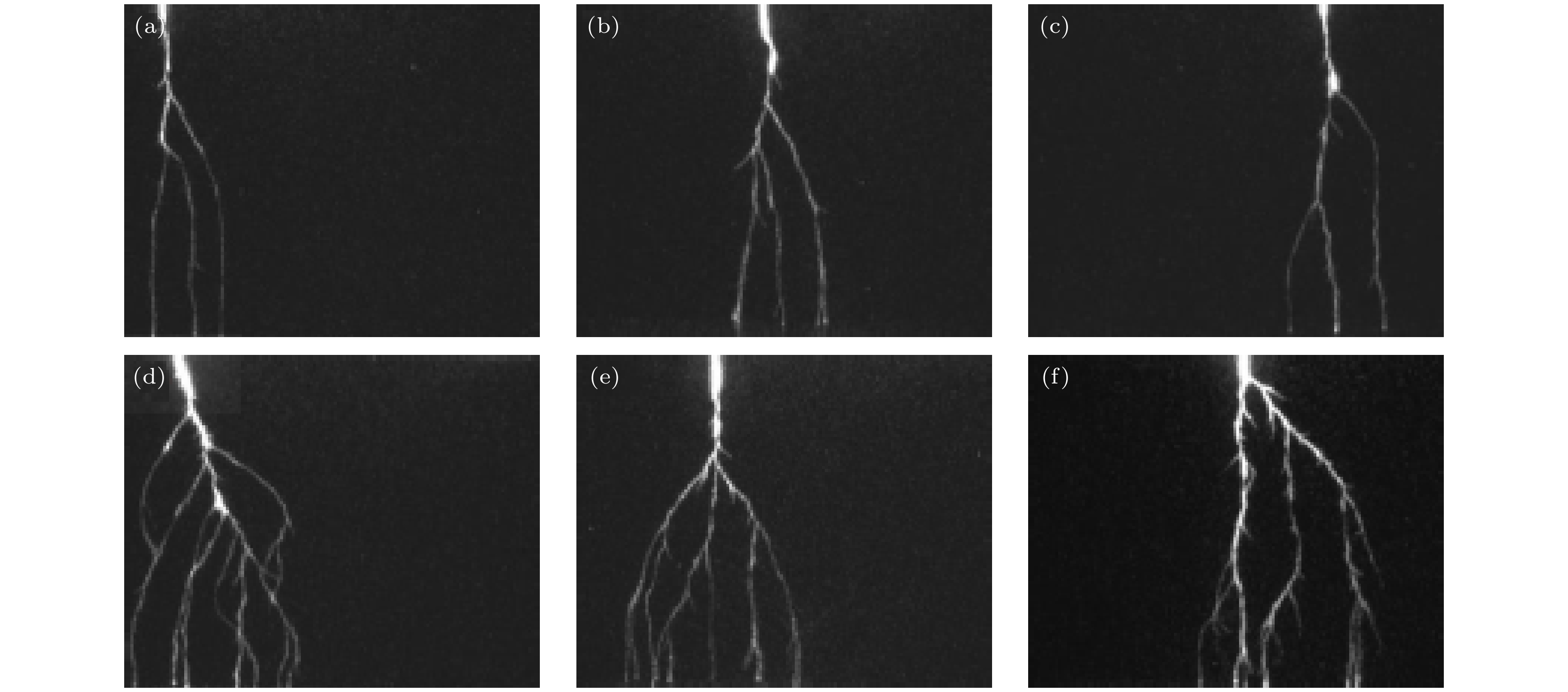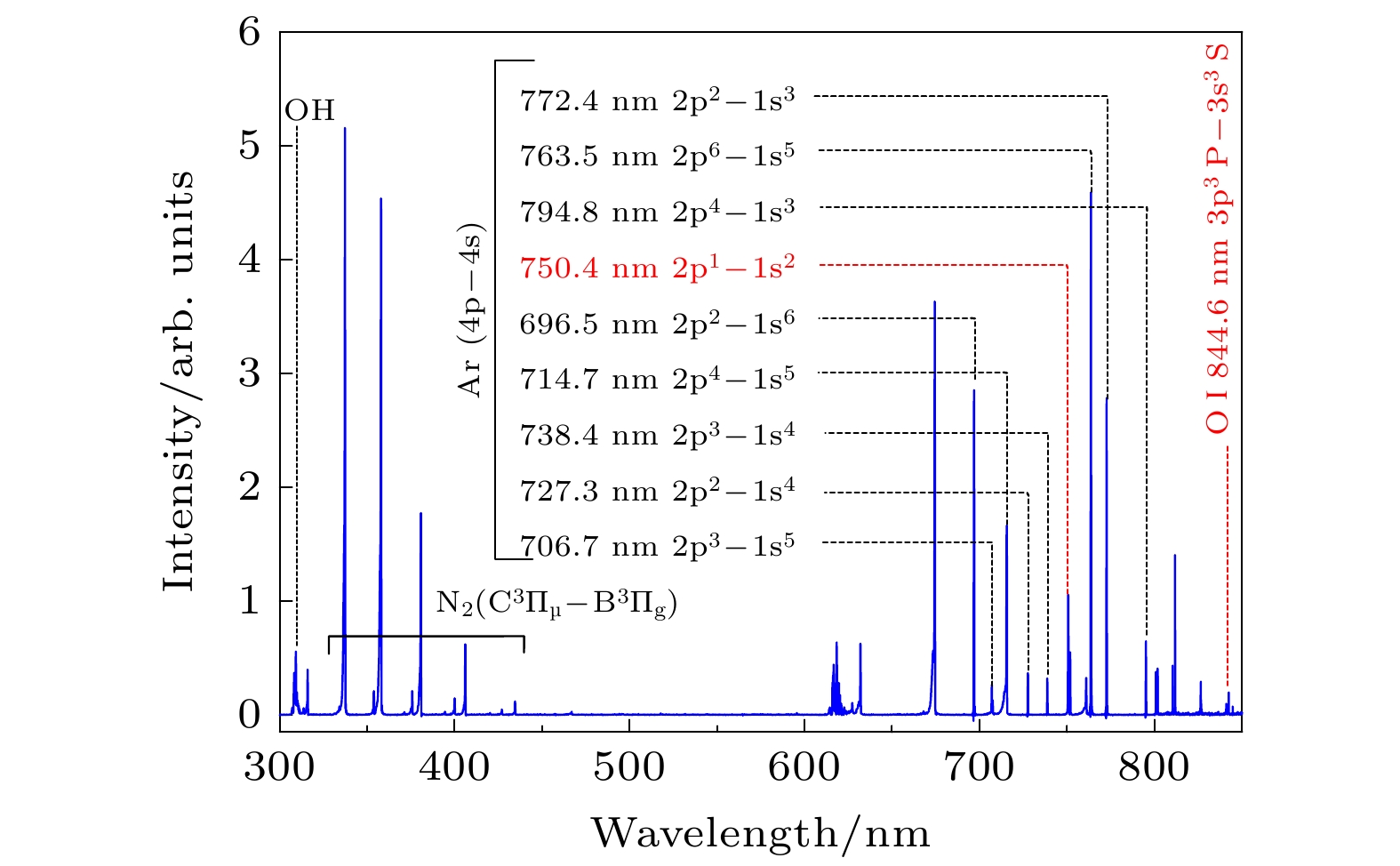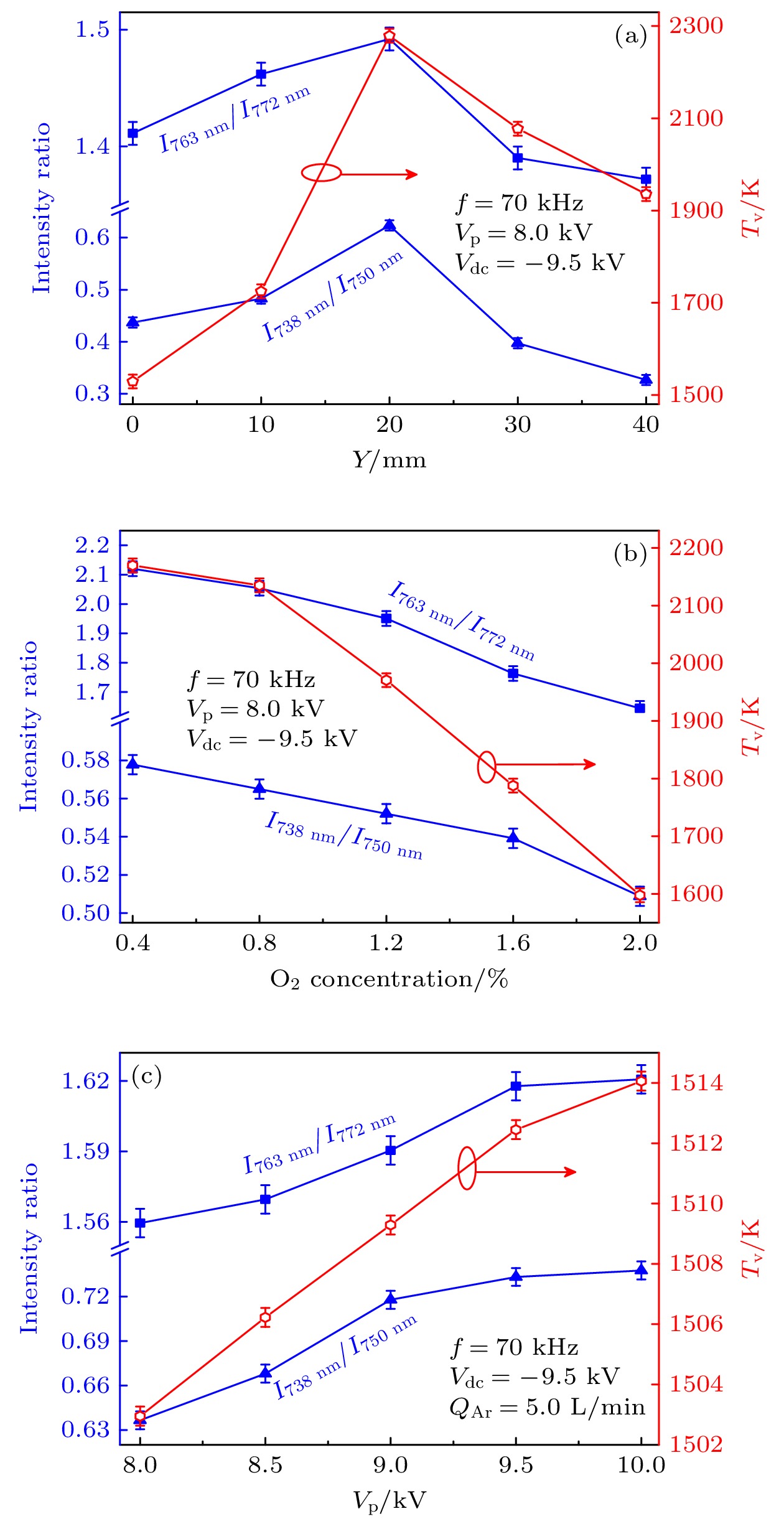-
大气压非平衡低温等离子体在生物医学和表面处理等方面具有广泛的应用前景, 引起研究者的关注. 等离子体射流是产生大气压非平衡等离子体的重要方式, 但通常产生的等离子体羽尺度较小. 针对于此, 本文采用一个具有三电极的介质阻挡放电装置, 在交流电压与负偏置电压的共同作用下, 在流动氩气的下游产生了大尺度刷状等离子体羽(50.0 mm × 40.0 mm). 结果表明, 随着交流电压峰值的增加, 等离子体羽的亮度增大. 通过快速影像, 研究发现视觉均匀的等离子体羽是由分叉流光的时间叠加构成的. 电压和发光信号波形表明交流电压的每个周期放电一次, 且放电出现于外加电压的正半周期. 随着交流电压峰值的增加, 分叉流光的分叉数量增多, 导致放电脉冲的持续时间增加且脉冲强度增强. 利用光谱仪测量了300—850 nm的发射光谱, 发现谱线包括308.0 nm处的OH (A2Σ+ —X2Π), N2 (C3Πu —B3Πg)的第二正带系, Ar I (4p—4s)以及844.6 nm处的O I (3p3 P—3s3 S). 基于发射光谱, 研究了分子振动温度及谱线强度比随实验参数的变化关系. 结果表明, 电子温度、分子振动温度和电子密度具有相似的变化趋势. 利用光化线强度比的方法, 研究了等离子体羽中氧原子浓度随实验参数的变化. 结果表明氧原子浓度沿气流方向先增加后降低, 随工作气体中氧气含量的增加先增加后降低. 此外, 氧原子浓度随交流电压峰值的增大而增加, 并对氧原子浓度的变化进行了定性的解释.Atmospheric pressure non-equilibrium low-temperature plasma has been widely used in biomedicine, surface treatment and other fields, which has attracted the attention of researchers extensively. As one of the important methods to generate such a plasma, the plasma jet has become a popular method, which can generate a remote plasma plume at the nozzle through introducing a rare gas flow. However, plasma plume has a small diameter, which results in deficiency for the large-scale surface treatment. A dielectric barrier discharge device with three electrodes is utilized to produce a large brush-shaped plasma plume (50.0 mm × 40.0 mm) downstream of flowing argon under the combined excitation of an alternate current (AC) voltage and a negative bias voltage, thereby increasing the plume scale. The results show that the luminescence intensity of the plasma plume increases with AC peak voltage increasing. By fast photography implemented with an intensified charge coupled device (ICCD), it is found that the plasma plume is composed of temporally superposed branched-streamers. The ICCD images also reveal that the number of branches increases with AC peak voltage increasing. Moreover, the waveforms of AC voltage and light emission signal recorded simultaneously indicate that the plasma plume initiates once per AC voltage cycle, which occurs in the positive half cycle of the applied voltage. With AC peak voltage increasing, the duration and intensity of discharge pulse increase, which results from more branches of the branched streamer. Besides, optical emission spectrum in a range from 300 nm to 850 nm mainly includes OH (A2Σ+–X2Π) peaked at 308.0 nm, the second positive system of N2 (C3Πu–B3Πg), Ar I (4p–4s), and O I (3p3 P–3s3 S) at 844.6 nm. Based on the optical emission spectrum, the plasma parameters such as vibrational temperature and intensity ratio of spectral lines (correlated with electron density and electron temperature) are investigated. Besides, the variation of concentration of oxygen atoms in the plasma plume with experimental parameters is investigated by optical actinometry. The results indicate that the concentration of oxygen atoms first increases and then decreases with the distance increasing along the argon flow direction or with oxygen content of the working gas increasing. In addition, the concentration of oxygen atoms increases with AC peak voltage increasing. All these results are discussed qualitatively. These results are of great importance in modifying the plasma surface on a large scale.
-
Keywords:
- plasma jet /
- branched streamer /
- optical emission spectrum /
- optical actinometry
[1] Liao X Y, Li J, Muhammad A I, et al. 2018 Food Control 90 241
 Google Scholar
Google Scholar
[2] Keidar M, Shashurin A, Volotskova O, Stepp M A, Srinivasan P, Sandler A, Trink B 2013 Phys. Plasmas 20 057101
 Google Scholar
Google Scholar
[3] Athanasopoulus D, Svarnas P, Ladas S, Kennou S, Koutsoukos P 2018 Appl. Phys. Lett. 112 213703
 Google Scholar
Google Scholar
[4] Daeschlein G, Woedtke T V, Kindel E, et al. 2010 Plasma Processes Polym. 7 224
 Google Scholar
Google Scholar
[5] Li X C, Liu R J, Li X N, Gao K, Wu J C, Gong D D, Jia P Y 2019 Phys. Plasmas 26 023510
 Google Scholar
Google Scholar
[6] Jung H, Kim W H, Oh I K, et al. 2016 J. Mater. Sci. 51 5082
 Google Scholar
Google Scholar
[7] Ning W J, Dai D, Zhang Y H 2019 Appl. Phys. Lett. 114 054104
 Google Scholar
Google Scholar
[8] Li X, Yang D Z, Yuan H, Zhao Z L, Zhou X F, Zhang L, Wang W C 2019 High Volt. 4 228
 Google Scholar
Google Scholar
[9] Massines F, Gherardi N, Naudé N, Ségur P 2005 Plasma Phys. Controlled Fusion 47 B577
 Google Scholar
Google Scholar
[10] Luo H Y, Liang Z, Lv B, Wang X X, Guan Z C 2007 Appl. Phys. Lett. 91 221504
 Google Scholar
Google Scholar
[11] Wang X X, Li C R, Lu M Z, Pu Y K 2003 Plasma Sources Sci. Technol. 12 358
 Google Scholar
Google Scholar
[12] Fang Z, Lin J, Xie X, Qiu Y, Kuffel E 2009 J. Phys. D: Appl. Phys. 42 085203
 Google Scholar
Google Scholar
[13] Lu X P, Laroussi M 2006 J. Appl. Phys. 100 063302
 Google Scholar
Google Scholar
[14] Teschke M, Kedzierski J, Finantu-Dinu E G, Korzec D, Engemann J 2005 IEEE Trans. Plasma Sci. 33 310
 Google Scholar
Google Scholar
[15] Kim D B, Rhee J K, Gweon B, Moon S Y, Choe W 2007 Appl. Phys. Lett. 91 151502
 Google Scholar
Google Scholar
[16] Sands B L, Ganguly B N, Tachibana K 2008 Appl. Phys. Lett. 92 151503
 Google Scholar
Google Scholar
[17] Zhu W D, Lopez J L 2012 Plasma Sources Sci. Technol. 21 034018
 Google Scholar
Google Scholar
[18] Walsh J L, Kong M G 2008 Appl. Phys. Lett. 93 111501
 Google Scholar
Google Scholar
[19] Ghasemi M, Olszewski P, Bradley J W, Walsh J L 2013 J. Phys. D: Appl. Phys. 46 052001
 Google Scholar
Google Scholar
[20] Cao Z, Walsh J L, Kong M G 2009 Appl. Phys. Lett. 94 021501
 Google Scholar
Google Scholar
[21] Tang J, Cao W Q, Zhao W, Wang Y S, Duan Y X 2012 Phys. Plasmas 19 031501
 Google Scholar
Google Scholar
[22] Li X C, Chu J D, Jia P Y, Li Y R, Wang B, Dong L F 2018 IEEE Trans. Plasma Sci. 46 582
 Google Scholar
Google Scholar
[23] Li X C, Chu J D, Zhang Q, Zhang P P, Jia P Y, Geng J L 2016 Appl. Phys. Lett. 109 204102
 Google Scholar
Google Scholar
[24] Liu X, Wang C C, Liu J Y, Wang C S, Yang Z K, Chen F Z, Song J L 2019 J. Appl. Phys. 125 123301
 Google Scholar
Google Scholar
[25] Li Q, Takana H, Pu Y K, Nishiyama H 2011 Appl. Phys. Lett. 98 241501
 Google Scholar
Google Scholar
[26] Li Q, Takana H, Pu Y K, Nishiyama H 2012 Appl. Phys. Lett. 100 133501
 Google Scholar
Google Scholar
[27] Li X C, Lin X T, Wu K Y, Ren C H, Liu R, Jia P Y 2019 Plasma Sources Sci. Technol. 28 055006
 Google Scholar
Google Scholar
[28] Jiang N, Ji A L, Cao Z X 2009 J. Appl. Phys. 106 013308
 Google Scholar
Google Scholar
[29] Kovach Y E, Garcia M C, Foster J E 2019 IEEE Trans. Plasma Sci. 47 3214
 Google Scholar
Google Scholar
[30] 李寿哲 2019 低温等离子体光谱理论基础及应用 (第1版) (大连: 大连理工大学出版社) 第185页
Li S Z 2019 Fundamentals of Low-temperature Plasma Spectroscopy and its Application (1st Ed.) (Dalian: Dalian University of Technology Press) p185 (in Chinese)
[31] Thiyagarajan M, Sarani A, Nicula C 2013 J. Appl. Phys. 113 233302
 Google Scholar
Google Scholar
[32] Zhang B, Zhu Y, Liu F, Fang Z 2017 Plasma Sci. Technol. 19 064011
 Google Scholar
Google Scholar
[33] Teodorescu M, Bazavan M, Ionita E R, Dinescu G 2015 Plasma Sources Sci. Technol. 24 025033
 Google Scholar
Google Scholar
[34] Wu K Y, Wu J C, Jia B Y, Ren C H, Kang P C, Jia P Y, Li X C 2020 Phys. Plasmas 27 082308
 Google Scholar
Google Scholar
[35] Li X C, Chen J Y, Lin X T, Wu J C, Wu K Y, Jia P Y 2020 Plasma Sources Sci. Technol. 29 065015
 Google Scholar
Google Scholar
[36] Xiao D Z, Cheng C, Shen J, Lan Y, Xie H B, Shu X S, Meng Y D, Li J G 2014 Phys. Plasmas 21 053510
 Google Scholar
Google Scholar
[37] Lieberman M A, Lichtenberg A J 1994 Principles of Plasma Discharges and Materials Processing (New York: Wiley) p550
[38] Shao X J, Chang Z S, Mu H B, Liao W L, Zhang G J 2013 IEEE Trans. Plasma Sci. 41 899
 Google Scholar
Google Scholar
[39] Lowke J J 1992 J. Phys. D: Appl. Phys. 25 202
 Google Scholar
Google Scholar
-
-
[1] Liao X Y, Li J, Muhammad A I, et al. 2018 Food Control 90 241
 Google Scholar
Google Scholar
[2] Keidar M, Shashurin A, Volotskova O, Stepp M A, Srinivasan P, Sandler A, Trink B 2013 Phys. Plasmas 20 057101
 Google Scholar
Google Scholar
[3] Athanasopoulus D, Svarnas P, Ladas S, Kennou S, Koutsoukos P 2018 Appl. Phys. Lett. 112 213703
 Google Scholar
Google Scholar
[4] Daeschlein G, Woedtke T V, Kindel E, et al. 2010 Plasma Processes Polym. 7 224
 Google Scholar
Google Scholar
[5] Li X C, Liu R J, Li X N, Gao K, Wu J C, Gong D D, Jia P Y 2019 Phys. Plasmas 26 023510
 Google Scholar
Google Scholar
[6] Jung H, Kim W H, Oh I K, et al. 2016 J. Mater. Sci. 51 5082
 Google Scholar
Google Scholar
[7] Ning W J, Dai D, Zhang Y H 2019 Appl. Phys. Lett. 114 054104
 Google Scholar
Google Scholar
[8] Li X, Yang D Z, Yuan H, Zhao Z L, Zhou X F, Zhang L, Wang W C 2019 High Volt. 4 228
 Google Scholar
Google Scholar
[9] Massines F, Gherardi N, Naudé N, Ségur P 2005 Plasma Phys. Controlled Fusion 47 B577
 Google Scholar
Google Scholar
[10] Luo H Y, Liang Z, Lv B, Wang X X, Guan Z C 2007 Appl. Phys. Lett. 91 221504
 Google Scholar
Google Scholar
[11] Wang X X, Li C R, Lu M Z, Pu Y K 2003 Plasma Sources Sci. Technol. 12 358
 Google Scholar
Google Scholar
[12] Fang Z, Lin J, Xie X, Qiu Y, Kuffel E 2009 J. Phys. D: Appl. Phys. 42 085203
 Google Scholar
Google Scholar
[13] Lu X P, Laroussi M 2006 J. Appl. Phys. 100 063302
 Google Scholar
Google Scholar
[14] Teschke M, Kedzierski J, Finantu-Dinu E G, Korzec D, Engemann J 2005 IEEE Trans. Plasma Sci. 33 310
 Google Scholar
Google Scholar
[15] Kim D B, Rhee J K, Gweon B, Moon S Y, Choe W 2007 Appl. Phys. Lett. 91 151502
 Google Scholar
Google Scholar
[16] Sands B L, Ganguly B N, Tachibana K 2008 Appl. Phys. Lett. 92 151503
 Google Scholar
Google Scholar
[17] Zhu W D, Lopez J L 2012 Plasma Sources Sci. Technol. 21 034018
 Google Scholar
Google Scholar
[18] Walsh J L, Kong M G 2008 Appl. Phys. Lett. 93 111501
 Google Scholar
Google Scholar
[19] Ghasemi M, Olszewski P, Bradley J W, Walsh J L 2013 J. Phys. D: Appl. Phys. 46 052001
 Google Scholar
Google Scholar
[20] Cao Z, Walsh J L, Kong M G 2009 Appl. Phys. Lett. 94 021501
 Google Scholar
Google Scholar
[21] Tang J, Cao W Q, Zhao W, Wang Y S, Duan Y X 2012 Phys. Plasmas 19 031501
 Google Scholar
Google Scholar
[22] Li X C, Chu J D, Jia P Y, Li Y R, Wang B, Dong L F 2018 IEEE Trans. Plasma Sci. 46 582
 Google Scholar
Google Scholar
[23] Li X C, Chu J D, Zhang Q, Zhang P P, Jia P Y, Geng J L 2016 Appl. Phys. Lett. 109 204102
 Google Scholar
Google Scholar
[24] Liu X, Wang C C, Liu J Y, Wang C S, Yang Z K, Chen F Z, Song J L 2019 J. Appl. Phys. 125 123301
 Google Scholar
Google Scholar
[25] Li Q, Takana H, Pu Y K, Nishiyama H 2011 Appl. Phys. Lett. 98 241501
 Google Scholar
Google Scholar
[26] Li Q, Takana H, Pu Y K, Nishiyama H 2012 Appl. Phys. Lett. 100 133501
 Google Scholar
Google Scholar
[27] Li X C, Lin X T, Wu K Y, Ren C H, Liu R, Jia P Y 2019 Plasma Sources Sci. Technol. 28 055006
 Google Scholar
Google Scholar
[28] Jiang N, Ji A L, Cao Z X 2009 J. Appl. Phys. 106 013308
 Google Scholar
Google Scholar
[29] Kovach Y E, Garcia M C, Foster J E 2019 IEEE Trans. Plasma Sci. 47 3214
 Google Scholar
Google Scholar
[30] 李寿哲 2019 低温等离子体光谱理论基础及应用 (第1版) (大连: 大连理工大学出版社) 第185页
Li S Z 2019 Fundamentals of Low-temperature Plasma Spectroscopy and its Application (1st Ed.) (Dalian: Dalian University of Technology Press) p185 (in Chinese)
[31] Thiyagarajan M, Sarani A, Nicula C 2013 J. Appl. Phys. 113 233302
 Google Scholar
Google Scholar
[32] Zhang B, Zhu Y, Liu F, Fang Z 2017 Plasma Sci. Technol. 19 064011
 Google Scholar
Google Scholar
[33] Teodorescu M, Bazavan M, Ionita E R, Dinescu G 2015 Plasma Sources Sci. Technol. 24 025033
 Google Scholar
Google Scholar
[34] Wu K Y, Wu J C, Jia B Y, Ren C H, Kang P C, Jia P Y, Li X C 2020 Phys. Plasmas 27 082308
 Google Scholar
Google Scholar
[35] Li X C, Chen J Y, Lin X T, Wu J C, Wu K Y, Jia P Y 2020 Plasma Sources Sci. Technol. 29 065015
 Google Scholar
Google Scholar
[36] Xiao D Z, Cheng C, Shen J, Lan Y, Xie H B, Shu X S, Meng Y D, Li J G 2014 Phys. Plasmas 21 053510
 Google Scholar
Google Scholar
[37] Lieberman M A, Lichtenberg A J 1994 Principles of Plasma Discharges and Materials Processing (New York: Wiley) p550
[38] Shao X J, Chang Z S, Mu H B, Liao W L, Zhang G J 2013 IEEE Trans. Plasma Sci. 41 899
 Google Scholar
Google Scholar
[39] Lowke J J 1992 J. Phys. D: Appl. Phys. 25 202
 Google Scholar
Google Scholar
计量
- 文章访问数: 6715
- PDF下载量: 88
- 被引次数: 0














 下载:
下载:






